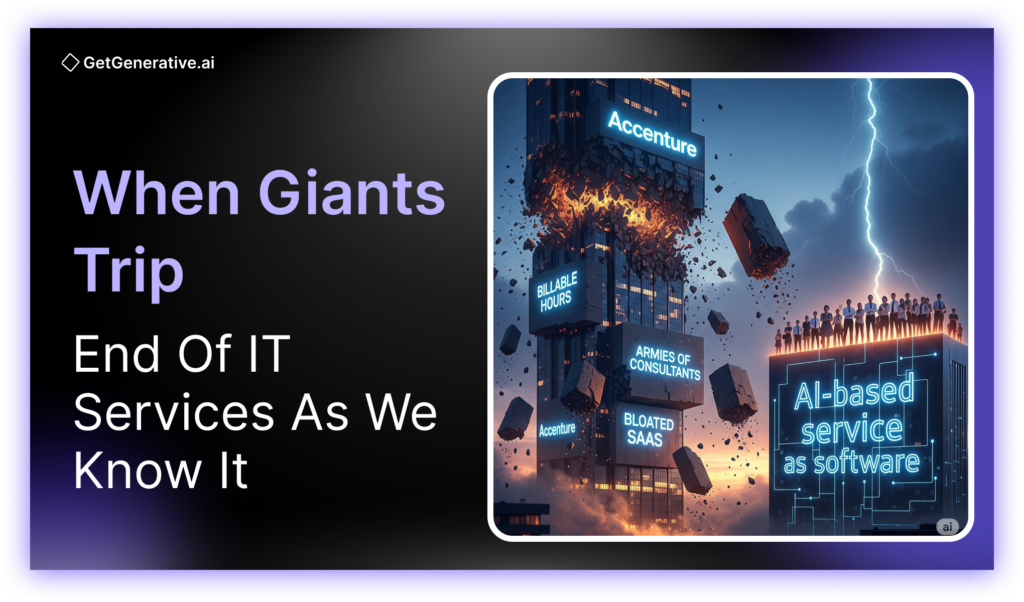When Giants Trip: End of IT Services as We Know It
Introduction: A Warning Bell for the Industry
In early 2025, Accenture’s stock soared to an all-time high of $394 per share with a market cap near $250 billion. Fast forward six months, and the picture looks dramatically different: the stock has plunged by nearly one-third, trading around $237 in August 2025, marking a 25–30% year-to-date decline even as broader markets rise.
This sharp fall is not merely about macroeconomic uncertainty. Instead, it reflects deeper structural forces reshaping IT services, with generative AI and automation threatening the very foundation of labor-intensive consulting. Investors, analysts, and industry watchers are asking a provocative question:
Is this the beginning of the end for the traditional IT services model?
Why Accenture’s Stock Is Sliding
Some of Accenture’s recent struggles stem from external headwinds, including:
- U.S. government spending cuts affecting consulting budgets.
- Broader economic caution slowing enterprise IT spending.
But these are only part of the story. The real driver is AI-driven disruption. Social media chatter, investor commentary, and analyst reports increasingly point to a central concern:
Why pay armies of consultants when AI-first platforms can do much of the work faster, cheaper, and more accurately?
Accenture’s own cautious earnings guidance reinforced these fears. Despite modest revenue growth, slowing bookings and weak contract signings highlighted that winning new business is getting harder in a world moving toward automation.
AI: The Double-Edged Sword for IT Services
Ironically, Accenture has been one of the earliest adopters and champions of AI. It reorganized itself around “reinvention services” and poured billions into AI-powered offerings. Yet this very pivot exposes a brutal reality:
Efficiency vs. Revenue Model Conflict
AI tools allow consultants to deliver the same work in a fraction of the time. But big consulting firms still depend on the traditional billable-hours model. If AI makes one consultant as productive as five, revenue per project inevitably shrinks.
Commercial Model in Flux
To adapt, firms are experimenting with fixed-fee or outcome-based pricing. While this aligns more closely with client needs, it often means lower near-term revenue and painful workforce restructuring.
As one analyst summarized:
“You charge for time, and when time goes away, you have to change the commercial model.”
Peter Thiel put it even more bluntly:
“If the consulting business was a stock, I’d be shorting it right now.”
The implication is stark: technology originators (building platforms and IP) may dominate the next era, while traditional service enablers risk decline.
The Provocative Question: Who Needs Accenture in the Age of AI?
Publications like The Economist and industry experts are raising a once-unthinkable question:
“Who really needs Accenture, Infosys, or Cognizant when AI agents can do much of the same work?”
For decades, IT services giants built empires by guiding enterprises through digital transformations—integrating systems, implementing software, writing code, and producing reports. But now, AI itself is threatening to transform Accenture out of business.
This isn’t just another cyclical downturn. It represents an era-defining shift where the very activities that fueled IT consulting for years—software integration, customization, testing—are being automated away.
Service-as-Software: The New Paradigm
Industry analyst Phil Fersht of HFS Research argues the future is “Service-as-Software.” Instead of paying for people-intensive projects or bloated SaaS platforms, enterprises will increasingly buy AI-powered, outcome-driven solutions that minimize human involvement.
Key points from HFS’s research:
- Broken Models: SaaS has become bloated and overpriced; IT services are still primarily human-labor businesses.
- The Shift: By 2030, much of routine consulting work will be replaced by AI-led, agentic services.
- The Market: HFS projects a $1.5 trillion Service-as-Software market by 2035, with enterprises replacing large parts of their professional services spend with AI solutions.
Already, signs of this shift are visible:
- Microsoft, Salesforce, and SAP are embedding AI directly into products, reducing the need for custom integration.
- Palantir bypasses traditional consultants by embedding its engineers directly with clients.
It is clear: the collision between service providers and software vendors is underway, and the winners will be those who deliver outcomes via AI-first platforms.
Big IT Providers Under Pressure
Accenture is not alone in its struggle. Other giants are also feeling the squeeze:
- TCS (Tata Consultancy Services) recently announced 12,000 layoffs (~2% of staff), citing AI-driven disruption—a shocking move for a company known for steady hiring. Its stock is already down 25% in 2025, dragging the entire Indian IT index into bear territory.
- Infosys has slowed hiring and is quietly reshaping its workforce by removing underperformers.
- Wipro, Capgemini, and Cognizant are aggressively investing in AI platforms but still face skepticism from markets.
The industry’s pyramid model—hiring thousands of freshers to scale projects—is breaking. AI is flipping the pyramid by automating repetitive, low-level work. As TCS’s CEO put it:
“We have been deploying AI at scale. Ways of working are changing. AI is offsetting the need for large-scale hiring.”
The result?
- Fewer entry-level jobs.
- Rising revenue per employee.
- A painful cultural reset for firms built on mass hiring.
Investors are reacting swiftly. Even when revenues rise, slowing bookings or hints of layoffs trigger stock selloffs. The fear is not about short-term bumps, but about a secular decline in the traditional consulting model.
The Innovator’s Dilemma: Cannibalize or Crumble
Big IT service providers are caught in a classic Innovator’s Dilemma. To survive, they must embrace AI and cannibalize their own legacy business models—even if it means short-term financial pain.
Challenges facing incumbents:
- Workforce Reinvention: Turning hundreds of thousands of programmers and analysts into AI supervisors and solution architects.
- Revenue Pressure: Moving from billable hours to outcome-based pricing inevitably shrinks top-line revenue before new streams mature.
- Cultural Resistance: A people-heavy business built on decades of headcount growth now has to embrace fewer people and more automation.
Accenture’s CEO, Julie Sweet, has launched a massive re-skilling program and a new AI-focused “Reinvention” unit. But Wall Street isn’t convinced a 700,000-person behemoth can pivot quickly.
The paradox is stark: if they don’t disrupt themselves, someone else will. If they do, their revenue models may collapse in the short term.
Also Read – The Innovator’s Dilemma for GSIs: How AI Pods Are Disrupting IT Service Models
Rise of the AI-Native Challengers
While incumbents wrestle with legacy baggage, AI-native players are rising rapidly. Companies like GetGenerative.ai are built from the ground up for the AI era, with no dependency on outdated models.
How AI-Native Firms Differ
- Human + Agent Pods: Instead of deploying teams of 15 consultants, GetGenerative.ai uses a 4-person pod of human experts augmented by AI agents that:
- Draft specifications.
- Write code.
- Generate test cases.
- Configure systems in minutes instead of weeks.
- Result: Delivery at 10× the speed and 45% less effort compared to traditional firms.
- Outcome-Based Pricing: Clients pay for results delivered, not hours worked. This aligns incentives directly with business value. Traditional consultancies, tied to hourly billing, struggle to match this.
- Culture of Agility: Born in the AI era, these firms attract talent excited to work with cutting-edge automation instead of manual, repetitive tasks.
As Phil Fersht of HFS notes, Service-as-Software models “eliminate the BS” by combining automation, AI-driven decisions, and pricing that reflects outcomes, not effort.
Why Traditional Giants Struggle to Pivot
Even if incumbents invest billions in AI or acquire startups, the pivot is painful:
- Legacy Revenue Trap: Decades of profitability from labor-heavy models make cannibalization unattractive.
- Investor Pressure: Stock markets punish headcount cuts at consulting firms (unlike Big Tech layoffs, which are seen as efficiency gains).
- Valuation Reset: As services become less labor-intensive, revenue may decline even if profitability improves, leading to shrinking market capitalization.
Case in point: TCS’s unprecedented 12,000 layoffs were viewed as an industry crisis, not as positive cost-cutting. It signaled falling demand, not efficiency.
The Future: Adapt or Be Disrupted
Accenture’s stock collapse is a canary in the coal mine. The IT services industry is at an inflection point, and the message from markets is clear: the people-heavy model has an expiration date.
What Comes Next?
- Winners: Firms that productize services, embrace AI platforms, and adopt outcome-based delivery models.
- Losers: Giants that cling to headcount-driven growth and hourly billing.
- Dark Horses: Mid-tier firms or software vendors that pivot quickly into AI-led “solutions as a service.”
The coming decade will be Darwinian. As HFS’s Phil Fersht notes:
“This isn’t a subtle shift. It’s a full-scale re-invention of enterprise technology. The old world of bloated SaaS and labor-based deals is firmly in the past.”
Conclusion: The Fast Fish Beat the Big Fish
The IT services model that fueled Accenture, TCS, Infosys, and Wipro for decades is being dismantled in real time. High-efficiency challengers like GetGenerative.ai are proving that lean teams with AI agents can deliver faster, better, and cheaper than armies of consultants.
For incumbents, the choice is stark:
- Adapt—embrace AI, reprice services, retrain workers, and invent new platforms.
- Or be disrupted—watch as clients flock to AI-native competitors.
History shows that in times of disruption, the fast fish beat the big fish. The Accenture of 2030 may survive—but only if it looks fundamentally different from the Accenture of today.
The end of IT services as we know it is not coming someday. It has already begun.



